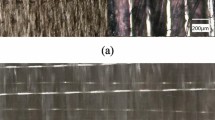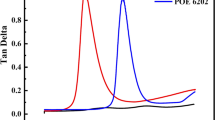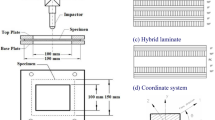Abstract
The impact properties of glass-fibre/impact-modifier/polypropylene (GF/IM/PP) hybrid composites were characterized using a number of impact test methods. For the IM/PP blends, the impact fracture toughness can be measured using linear elastic fracture mechanics (LEFM) approach. For the GF/IM/PP hybrids, due to their non-compliance with LEFM, the essential work of fracture approach was employed. The impact properties of the IM/PP blends increased with IM concentration, while that of the GF/IM/PP hybrids did not change very much with IM content. It was concluded that cavitation of the PP matrix around the IM particles was the major toughening mechanism in the IM/PP blends. However, in the GF/IM/PP hybrids, the toughening effect due to cavitation was suppressed due to the introduction of short glass fibres (≈15 vol%). It is believed that the local stress in the matrix was relieved by fibre/matrix debonding of the relatively weak fibre/matrix interface. Thus, the presence of the IM particles was rendered insignificant in the GF/IM/PP hybrids.
Similar content being viewed by others
References
S. C. Tjong, J. S. Shen and R. K. Y. Li, Polymer 37 (1996) 2309.
J. S. Shen and R. K. Y. Li Idem., Polym. Eng. Sci. 36 (1996) 100.
D. E. Spahr, K. Friedrich, J. M. Schultz and R. S. Bailey, J. Mater. Sci. 25 (1990) 4427.
S. F. Bush, F. Yilmaz and P. F. Zhang, Plast. Rubb. & Compos. Process. Appl. 24 (1995) 139.
J. Karger-Kocsis, T. Harmia and T. Czigany, Comp. Sci. Technol. 54 (1995) 287.
S. Hashemi and M. Koohgilani, Polym. Eng. Sci. 35 (1995) 1124.
L. S. Chen, Y. W. Mai and B. Cotterell, omPolym. Eng. Sci.ibid. 29 (1989) 505.
T. Vu-Khanh, J. Thermoplastic Compos. Mater. 4 (1991) 46.
P. H. Th. Vollenberg and D. Heikens, J. Mater. Sci. 25 (1990) 3089.
J. Karger-Kocsis, Polymer 20 (1979) 37.
J. Karger-Kocsis and V. N. Kuleznev, omPolymer ibid. 23 (1982) 699.
C. J. Chou, K. Vijayan, D. Kirby, A. Hittner and E. Baer, J. Mater. Sci. 23 (1988) 2521.
W. Y. Tam, T. Cheung and R. K. Y. Li, Polymer Testing 15 (1996) 363.
S. V. Nair, M. L. Shiao and P. D. Garrett, J. Mater. Sci. 27 (1992) 1085.
W. Y. Chiang, W. D. Yang and B. Pukanszky,Polym. Eng. Sci. 32 (1992) 641.
J. G. Williams, “Fracture Mechanics of Polymers” (Ellis Harwood, Chichester, 1984).
J. S. Wu, Y. W. Mai and B. Cotterell, J. Mater. Sci. 28 (1993) 3373.
J. S. Wu and Y. W. Mai, Polym. Eng. Sci. 36 (1996) 2275.
S. Hashemi and J. Mugan, J. Mater. Sci. 28 (1993) 3983.
Author information
Authors and Affiliations
Rights and permissions
About this article
Cite this article
Tam, W.Y., Cheung, T.Y.H. & Li, R.K.Y. Impact properties of glass fibre/impact modifier/polypropylene hybrid composites. Journal of Materials Science 35, 1525–1533 (2000). https://doi.org/10.1023/A:1004701501431
Issue Date:
DOI: https://doi.org/10.1023/A:1004701501431




